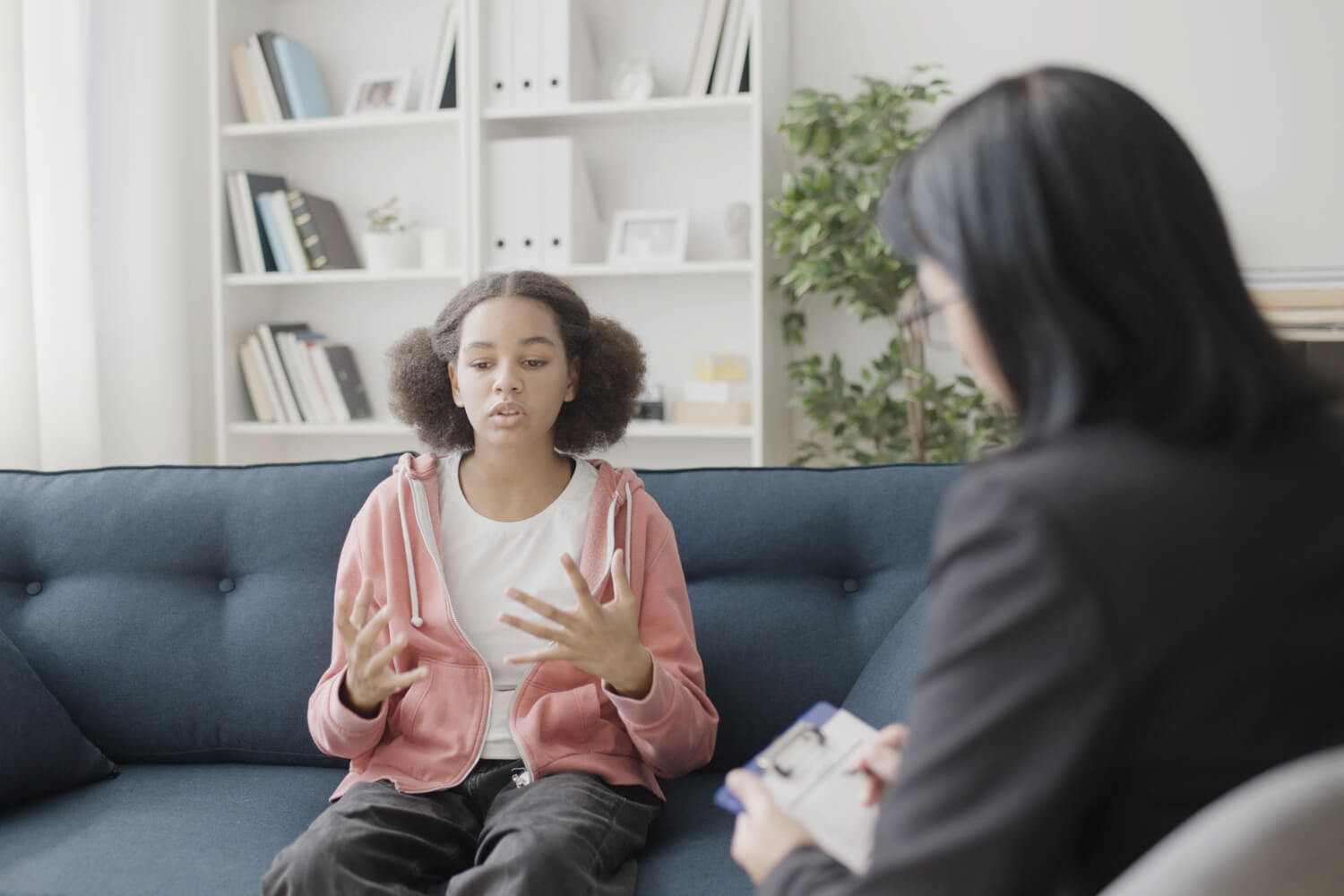Discovering the Different Kinds of Therapy Readily Available for Teenagers With a Therapist for Teens
Teens face distinct obstacles that can impact their psychological health and wellness. Numerous therapeutic techniques are tailored to address these issues efficiently. From Cognitive-Behavioral Therapy (CBT) to Art Therapy, each method uses unique advantages. Understanding these treatments can aid caretakers make informed choices. What variables should be taken into consideration when picking the appropriate technique for a teenager? The exploration of these various therapies exposes insights that can significantly enhance adolescent wellness.
Understanding Cognitive-Behavioral Treatment (CBT) for Teens
Cognitive-Behavioral Therapy (CBT) serves as an effective tool for addressing the distinct psychological wellness difficulties faced by teenagers. This evidence-based approach concentrates on the interplay between actions, thoughts, and sensations, aiding teens determine and change negative idea patterns that add to their struggles. Via organized sessions, specialists direct teenagers in acknowledging their cognitive distortions, promoting healthier coping systems and psychological policy.
CBT is particularly reliable in managing anxiousness, depression, and behavioral issues, as it outfits teens with functional skills to navigate their every day lives. The treatment urges self-reflection and promotes an aggressive state of mind, encouraging teens to take control of their mental wellness trip. By setting particular objectives and utilizing various methods, such as journaling and role-playing, CBT fosters strength and self-awareness. In general, this restorative strategy provides teenagers with important devices to face their difficulties and build a much more favorable expectation on life.
The Advantages of Dialectical Actions Therapy (DBT)
While lots of therapeutic strategies provide useful understandings for teens, Dialectical Behavior modification (DBT) stands apart for its performance in dealing with emotional guideline and interpersonal difficulties. Established by Dr. Marsha Linehan, DBT incorporates cognitive-behavioral strategies with mindfulness methods, making it particularly suitable for teens coming to grips with intense feelings. This therapy aids teens recognize and understand their feelings, advertising healthier feedbacks to stress factors.
One of the substantial benefits of DBT is its emphasis on structure abilities in four key locations: mindfulness, social performance, distress resistance, and psychological guideline. These skills empower teenagers to cope and browse complex relationships with difficult circumstances a lot more properly. Furthermore, DBT encourages a solid therapeutic alliance between the specialist and the adolescent, cultivating trust fund and openness. Because of this, several teenagers experience enhanced psychological stability and enhanced coping systems, eventually resulting in an extra meeting life and more powerful connections with peers and family.
Discovering Art Therapy as an Innovative Electrical outlet
Art treatment provides teens a distinct method for self-expression and psychological exploration (Youth Counselling Near Me). Via different strategies and methods, it enables them to interact sensations that may be difficult to articulate vocally. By involving in innovative activities, teenagers can experience healing benefits that promote psychological well-being
Advantages of Art Treatment
Participating in art therapy gives teens with a distinct innovative electrical outlet that fosters psychological expression and individual insight. This healing approach permits teenagers to communicate sensations and experiences that might be challenging to articulate verbally. Via numerous forms of imaginative expression, such as drawing, painting, or sculpting, teens can explore and process complicated feelings, leading to boosted self-awareness. Additionally, art therapy advertises relaxation and tension relief, supplying a safe area for individuals to launch stifled feelings. The non-judgmental setting urges experimentation, assisting teenagers develop self-confidence in their imagination and problem-solving abilities. Therefore, art treatment can boost overall mental wellness, supplying a valuable tool for dealing with life's difficulties throughout this critical developmental phase.
Techniques and methods
When checking out art treatment as an imaginative electrical outlet, different methods and techniques can be used to assist in emotional expedition and expression. These might consist of illustration, collage-making, sculpting, and painting, allowing teens to communicate sensations that could be challenging to verbalize verbally. Led imagery can additionally be made use of, motivating individuals to visualize and create representations of their emotions. In addition, the consolidation of music or movement can improve the innovative process, promoting a much deeper connection to their internal experiences. Team art tasks give chances for social communication and shared recovery. Importantly, the emphasis in art treatment lies not on creative skill but on the procedure of production, encouraging teenagers to discover their own distinct types of self-expression and insight.
Art as Expression
Creativity offers as an effective avenue for self-expression, specifically for teenagers steering intricate emotions. Art therapy offers a special outlet for teens to discover and connect feelings that might be tough to express vocally. Via attracting, painting, or sculpting, teenagers can imagine their internal battles, fostering a sense of understanding and launch. This healing method enables personal interpretation and urges exploration without judgment. Furthermore, participating in creative activities can improve self-esteem and advertise psychological strength. As teenagers create, they may locate brand-new viewpoints on their challenges, resulting in recovery and personal growth. Ultimately, art treatment acts as an important source, encouraging teenagers to browse their psychological landscapes via creative expression.
The Role of Family Therapy in Teenager Mental Wellness

Benefits of Household Involvement

Interaction and Problem Resolution
Reliable interaction and conflict resolution are necessary parts of adolescent website link mental health and wellness, especially within the context of family members therapy. Household treatment offers an organized setting where teens can share their ideas and sensations, cultivating open dialogue. This restorative setup encourages household members to actively listen to every other, promoting understanding and empathy. By addressing conflicts in a risk-free space, teens discover beneficial abilities for managing differences constructively, which can reduce psychological distress. In addition, these skills boost family members characteristics, bring about much healthier relationships. As teenagers browse the intricacies of their feelings, household therapy outfits them with devices to communicate properly, willpower disputes agreeably, and reinforce domestic bonds, eventually supporting their overall psychological health.
Making Use Of Mindfulness-Based Therapy for Stress And Anxiety Decrease
As teens browse the intricacies of teen life, incorporating mindfulness-based treatment can offer as an effective tool for tension decrease. This healing strategy emphasizes present-moment awareness, helping teenagers challenge their ideas and feelings without judgment. By practicing mindfulness methods such as deep breathing, body scans, and assisted imagery, adolescents can learn to take care of anxiousness and stress and anxiety better.
Research study shows that mindfulness-based treatment can boost emotional regulation and strength in teenagers, enabling them to cope much better with social obstacles and academic stress (Youth Counselling). Routine practice can lead to boosted emphasis, lowered impulsivity, and better general health. Additionally, mindfulness fosters a feeling of link to oneself, promoting self-compassion and reducing negative self-talk
Incorporating mindfulness right into therapy sessions offers teenagers practical techniques they can use in day-to-day life, encouraging them to navigate stressors with better ease and confidence. Consequently, mindfulness-based therapy ends up being a necessary source in supporting teen mental health.
Integrating Play Therapy for Younger Teenagers and Preteens

Specialists trained in this technique create a risk-free environment where younger teenagers can explore their issues and create coping approaches. By participating in play, these people can much better understand their feelings and learn Visit Your URL to navigate social communications. Additionally, play treatment can foster strength and analytic skills, crucial for navigating the obstacles of teenage years. Overall, incorporating play treatment can improve the restorative procedure, supplying younger teens and preteens with the devices they need to prosper emotionally and socially.
Regularly Asked Questions

Exactly how Do I Know if My Teen Needs Treatment?
Indicators that a teenager may require treatment include relentless despair, adjustments in actions, withdrawal from pals or tasks, academic decrease, boosted anxiety, material usage, or difficulty handling life changes. Observing these indications can trigger professional analysis.
What Certifications Should I Look for in a Teenager Therapist?
When looking for a teen therapist, one should prioritize credentials such as pertinent degrees in psychology or counseling, state licensure, specialized training in adolescent problems, and experience working with young adults in different restorative setups.
Exactly How Can I Assistance My Teen Throughout Therapy?
To sustain a teen throughout therapy, one ought to actively pay attention, use support, respect their personal privacy, and validate their sensations. Furthermore, fostering open interaction can aid them really feel a lot more comfortable reviewing their experiences and feelings.
What Are Usual Indications of Mental Health Issues in Teenagers?
Typical indicators of psychological wellness issues in teens include persistent unhappiness, withdrawal from good friends and activities, adjustments in sleep or hunger, problem focusing, increased irritability, material misuse, and noticeable declines in scholastic performance or self-confidence. (Youth Therapist)
For How Long Does Treatment Normally Last for Teenagers?
Therapy duration for teenagers normally varies, typically lasting from a few weeks to a number of months. Aspects influencing this timeline include the person's specific needs, the type of treatment, and progression made during sessions.
From Cognitive-Behavioral Therapy (CBT) to Art Therapy, each technique provides distinctive benefits. Cognitive-Behavioral Therapy (CBT) serves as a powerful device for attending to the unique mental health challenges dealt with by teenagers. Engaging in art treatment offers teens with a distinct imaginative outlet that cultivates emotional expression and individual insight. Family members treatment offers an organized atmosphere where teens can reveal their sensations and thoughts, fostering open dialogue. Research shows that mindfulness-based treatment can boost psychological guideline and resilience in teenagers, allowing them to deal far better with social challenges and scholastic stress.